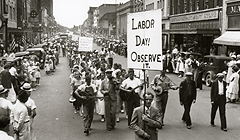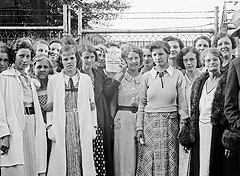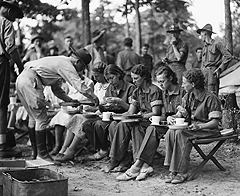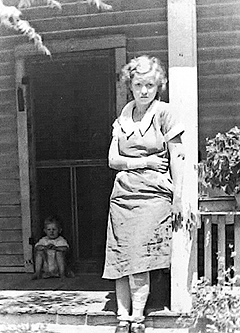1934: Southern Workers Spark Massive Textile Strike
August 31, 2013
In 1934, thousands of workers in Southern textile mills walked off the job seeking better pay and working conditions. The job actions they launched spread to New England and the Mid-Atlantic states and became one of the biggest industrial strikes in U. S. history. Though the strike was unsuccessful, it helped pave the way for stronger laws to protect workers seeking to join unions.
By the early 1930s, approximately 70 percent of American textile production had shifted from New England to southern states, where manufacturers took advantage of dispossessed farmers and unemployed laborers who were willing to work for less.
To keep profits up, textile manufacturers had also begun the practice of “stretch-outs” on the factory floor: paying reduced “piece rates,” limiting breaks, and hiring more supervisors to discipline workers and speed production.
Most of the textile employees in the south were poor whites who lived near the mills. (Southern textile manufacturers largely refused to hire African-Americans.) Workers routinely labored 55 to 60 hours per week on dangerous machinery and brought home less than $10.
The mill workers had little experience challenging the economic and political structure in their communities, but they did not take kindly to the stretch-outs and decided to make a stand. In 1929, employees at textile factories in South Carolina spontaneously walked off the job to protest working conditions more than 80 times. Hundreds of other strikes took place that year, including job actions in Gastonia NC and Elizabethton TN. Some succeeded, but most failed due to a lack of organized union support and the often violent tactics of the mill owners.
Meanwhile, reduced wages and stretch-outs were causing unrest among wool workers in New England, silk weavers in New Jersey, and across the entire industry.
NIRA
In June 1933, with the Great Depression in full force, Congress and the administration of Franklin D. Roosevelt sought to address the country’s economic woes in part by passing the National Industrial Recovery Act (NIRA).
 To build cooperation among businesses and unions, expand employment, raise wages, and protect workers who sought to join unions, the law established the National Recovery Administration (NRA) to develop codes of conduct for particular industries.
To build cooperation among businesses and unions, expand employment, raise wages, and protect workers who sought to join unions, the law established the National Recovery Administration (NRA) to develop codes of conduct for particular industries.
The NRA established the Cotton Textile Board to foster fair competition, regulate prices, prevent over-production of textile goods, and guarantee workers a minimum wage. With great expectations for labor protections under the NIRA, tens of thousands of southern cotton mill workers joined the United Textile Workers union. UTW membership rocketed from 15,000 in February 1933, to 250,000 by June 1934.
Mill owners, however, came to dominate the board. They ignored the intent of the law, developed self-serving standards, and began “stretching out the stretch-out,” wrote historians James Leloudis and Kathryn Walbert. They “effectively turned the minimum wage into the maximum that most workers could earn and laid off thousands of additional hands.”
Strike Begins
Most southern mill owners “refused to negotiate with or recognize any union representation,” wrote B.J. Davis for North Carolina’s Museum of History. “Wages remained low, the stretch-out was still common.” In July 1934, 20,000 frustrated Alabama workers walked out of their mills, demanding an end to the stretch-out, a $20 minimum wage for a 30-hour work week, union recognition, and reinstatement of workers fired for union activity, Leloudis and Walbert noted.

With workers in other states eager to begin similar actions, at a convention that summer the UTW hastily called for an industry-wide strike.
The union promised full support, but had too little time to plan, too few staff, and inadequate finances for a lengthy faceoff with the mill owners and politicians who were determined to fight.
On Sept. 3, 1934, nearly 10,000 workers marched in the Labor Day parade in Gastonia NC, where authorities had brutally suppressed a textile strike five years earlier. The next day, 20,000 of the city’s mill workers walked off the job. The strike spread swiftly through the south and to northern textile mills as well, outpacing the UTW’s ability to coordinate events and provide assistance. By mid-September, more than 400,000 textile workers had walked off the job demanding an end to the stretch-outs and union recognition.
Backlash
Though the strike caused a sharp decline in textile production, most mill owners had well-stocked warehouses and were determined to defeat the strikers once and for all.

Insisting that union agitators were coercing employees to go on strike, “mill owners across the South responded to the strike by combining ‘armed self-defense with calls for military intervention,’” wrote Leloudis and Walbert.
The mill bosses called on their political supporters for help. South Carolina Gov. Ibra Charles Blackwood immediately deputized the state’s “mayors, sheriffs, peace officers and every good citizen” to “maintain order,” then “dispatched the National Guard with orders to shoot to kill any picketers who tried to enter the mills.” Gov. Ehringhaus of North Carolina followed suit on Sept. 5.
The governors of Maine and Rhode Island also called out the Guard, as did Georgia Gov. Eugene Talmadge, who declared martial law and ordered that picketers be arrested and held pending trial by a military tribunal at a former World War I prisoner of war camp.
Southern mill operators got especially rough, hiring strikebreakers to intimidate workers and beat union activists.
On Sept. 6, J.D. Beacham, the superintendent of the Chiquola Mill in Honea Path SC, and the mayor ordered police and 100 private guards to open fire on workers who had gathered at the mill to protest working conditions and wages. A “hail of fire from non-union workers and special deputies” killed seven workers and wounded a score of others, the Anderson Independent reported, leaving wives and children “sobbing in agony as they rushed to the sides of their dead.”
Many other strikers also paid dearly for showing up on picket lines. Three were shot in Georgia, one in Rhode Island, and hundreds were beaten or jailed.
The strikers soon came to realize the odds were against them and that there was not much the UTW and the NIRA could do to protect them.
Three weeks after the strike began, faced with brute force and financial need, workers began returning to the mills. On Sept. 22, the UTW called off the job action and declared victory, saying it had scored points for the workers and that their efforts would bear fruit under a Textile Labor Relations Board the Roosevelt Administration was to create.
In reality, however, the strike was a stunning defeat. The UTW achieved no gains, and southern employers refused to reinstate many thousands of strikers.
Legacy
While many hailed the labor protections proposed in the NIRA, the law lacked effective enforcement mechanisms and did little to help unions organize workers.
In May 1935, the U.S. Supreme Court overturned the NIRA, but two months later President Roosevelt signed into law the National Labor Relations Act, which more firmly established workers’ legal rights to join unions, engage in collective bargaining, and strike if necessary.
While that law and the 1938 Fair Labor Standards Act helped unions lift millions of workers out of poverty, union attempts to organize workers in the south have continued to lag. Nonetheless, today textile manufacturers have largely moved production to overseas sweatshops, and the fight for justice for textile workers has gone global.



